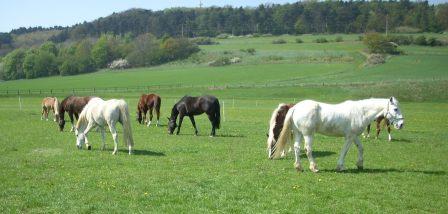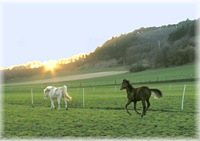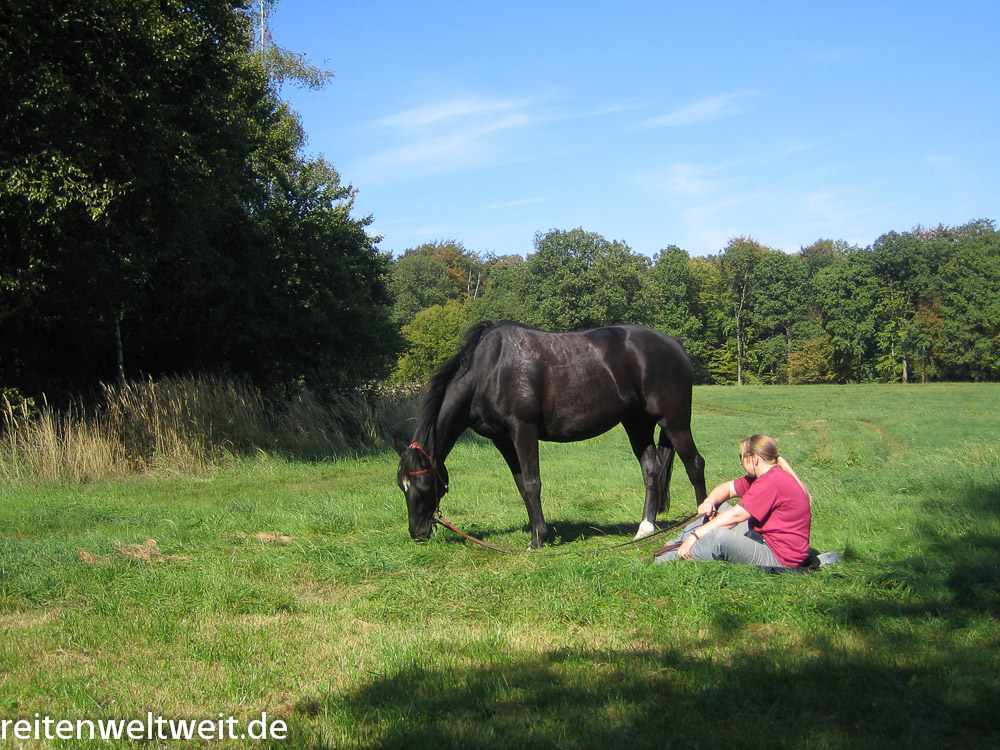Movement, pasture, social contacts: Species-appropriate husbandry for horses
 But what is species-appropriate husbandry?
But what is species-appropriate husbandry?
For many years horses were forced to live in tiny stables. Sometimes there were so small that the horse could not even turn around. Some horses never had contact to other animals and rarely spent any time on the pasture.
For more than 22 hours a day horses have no other option but starring on the walls of their stable. If the horse is lucky the rider comes once a day and rides the horse for one hour in a dusty riding area. This, definitely, is no species-appropriate husbandry!
Thanks god, this way of husbandry has changed in the course of the last decades. Generally you can talk about a positive development – but this, of course, is not enough! Still there are too many cases of desolated horses that are forced to live under terrible conditions.
One needs to remember: Originally horses are nomads that walk nearly four miles a day!
This slow and continuous movement was essential for the survival of the flight animal: It trained the physical fitness of the horse so that it was able to run away and escape at any time. Nowadays it is nearly impossible to guarantee these living conditions. It requires a lot of space, money and time.
But when it seems to be impossible to guarantee the original lifestyle of the horse, at least we need to agree on “species-appropriate husbandry – the best as possible”.
Movement, balanced feed (minerals, vitamins, fruits and vegetables), light, social contacts and a minimum of intellectual work – these are the five basic needs of every horse.
A good horse owner cares about a species-appropriate husbandry. A horse does not only need enough movement and space but also social contacts, variety, light and fresh air.
- Slow and continuous movements, enough space for stretching, rolling, wild bucking and cantering – all these things are essential for a balanced spirit and the physical health of the horse. One should not forget that horses originally run through nature between 10-16 hours a day (usually for reasons of foraging).
- Horses need small feed portions several times a day. One or two big feed portions a day do not fit to the small stomach of the horse.
- Natural light is essential for every animal. It guarantees orientation about the natural day and night rhythm that influences the activity and production processes of the horses´ organism (to give an example: Day light is indispensable for the production of vitamin D).
- Fresh air is important for the entire respiratory tract. Horses especially need to be set out to the natural environmental stimuli of the seasons. This contact supports and strengthens the immune system of the horse and therefore prevents allergies and other infectious diseases.
- Horses are gregarious animals. They need the contact and direct conflicts with other horses.
- Horses are smart animals and want to have a minimum of intellectual work. Besides the normal physical training in the riding arena the horse owner should also try out some ground work training units. The best variety to the daily stable life is a great ride through nature – and with the correct equipment this is possible at any time of the year!
Surf tips: Here you can find plenty of ideas about interesting things to do with your horse.
- Ground training: exercises with colorful ground bars activate the awareness of horses
- Colorful ideas against dark and endless winter days – ground training
- Moonlight riding – perfect for short and dark days
- Enjoy the summer – horses and water
- Get past the fear: training units that help horses to overcome their anxieties – Part 1
A horse owner who does not guarantee these basic needs of the horse should not wonder if the vet needs to come very often. A non species-appropriate husbandry causes chronic respiratory diseases, problems with the locomotor system, stable vices like weaving, head shaking, horse cribbing, colics and a lot more…
Generally there are five different types of horse husbandry
Horses are tied on a moveable bar
Thanks god only few horses owners still use this terrible way of horse husbandry. The horse simply is tied on a moveable bar or iron chain. The animal can hardly move and has no contacts with other horses.
Horse stable husbandry
Most frequently horses live in a horse stable. In this case the horse owner needs to guarantee that the horse spends at least 2-3 hours a day on the pasture and that the animal has contact to other horses. The stable itself needs to be bright and airy. Advantage for the horse owner: All day long the horse is available and clean – and therefore ready for a ride. Here you can find all information about the perfect horse bedding.
Paddock husbandry
This is the great alternative for the standard horse stable. The normal stable directly is connected with a small paddock. This means additional space and variety for the horse. Disadvantage for the rider: sometimes your horse can be completely wet when you want to ride it (some horses prefer to stay in the rain than in their dry stable).
Husbandry on the pasture or in an open stable
This type of horse husbandry clearly is the best one. The horse can nearly live its original lifestyle and the rider benefits from a relaxed horse. However, the horse owner needs to consider some important aspects. First of all the horse always needs a shelter that protects him from wind and rain. This shelter must be free of mud. Additionally one can think about a separate stable for ill horses. This type of husbandry however also has some disadvantages for the rider. After a rainy or wet day the horse can be very dirty so that the grooming process takes a very long time. If the horse is too wet it can be even impossible to ride the horse at all.
Exercise pen
The horses live on a pasture which is separated into different “zones”. If the horse wants to drink, eat, roll, canter or play with other horses it has to go to the respective zone. You could say that the horse needs to think and organize its life. This guarantees intellectual work and additional possibilities for movement.
Only few horse owners provide a species-appropriate husbandry
Unfortunately only few horse owners provide a species-appropriate husbandry for horses – especially in the top-class sports. Even if a stable has a seal of approval from the FN this does not guarantee a great and acceptable life for the horses inside. The seal only means that there are no serious deficiencies – but this clearly does not mean species-appropriate husbandry!
Surf tips:
- Get past the fear: training units that help horses to overcome their anxieties- Part 1
- Get past the fear: training units that help horses to overcome their anxieties- Part 2
- The importance of the right communication between horse and rider- how to understand the body language of the horse
—All statements without guarantee—



One Comment